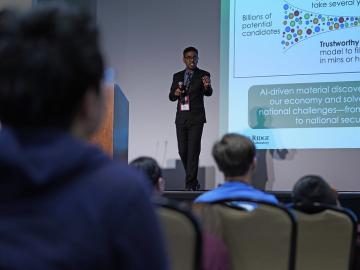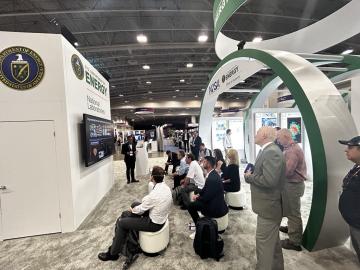
Filter News
Area of Research
- Biology and Environment (15)
- Clean Energy (34)
- Computational Biology (1)
- Computational Engineering (1)
- Computer Science (2)
- Electricity and Smart Grid (1)
- Fusion and Fission (4)
- Fusion Energy (3)
- Isotopes (2)
- Materials (7)
- Materials for Computing (4)
- Mathematics (1)
- National Security (4)
- Neutron Science (5)
- Nuclear Science and Technology (6)
- Nuclear Systems Modeling, Simulation and Validation (1)
- Sensors and Controls (1)
- Supercomputing (12)
- Transportation Systems (1)
News Type
News Topics
- (-) Advanced Reactors (14)
- (-) Artificial Intelligence (30)
- (-) Biomedical (26)
- (-) Clean Water (12)
- (-) Grid (19)
- (-) Machine Learning (13)
- (-) Transportation (28)
- 3-D Printing/Advanced Manufacturing (43)
- Big Data (22)
- Bioenergy (26)
- Biology (33)
- Biotechnology (8)
- Buildings (16)
- Chemical Sciences (15)
- Climate Change (28)
- Composites (8)
- Computer Science (63)
- Coronavirus (19)
- Critical Materials (6)
- Cybersecurity (4)
- Decarbonization (19)
- Education (1)
- Emergency (1)
- Energy Storage (30)
- Environment (64)
- Exascale Computing (11)
- Fossil Energy (3)
- Frontier (9)
- Fusion (21)
- High-Performance Computing (27)
- Isotopes (19)
- ITER (4)
- Materials (33)
- Materials Science (47)
- Mathematics (7)
- Mercury (4)
- Microscopy (13)
- Molten Salt (1)
- Nanotechnology (11)
- National Security (17)
- Net Zero (5)
- Neutron Science (30)
- Nuclear Energy (35)
- Partnerships (11)
- Physics (14)
- Polymers (7)
- Quantum Computing (11)
- Quantum Science (25)
- Security (6)
- Simulation (13)
- Space Exploration (8)
- Statistics (2)
- Summit (19)
- Sustainable Energy (55)
- Transformational Challenge Reactor (3)
Media Contacts

Two ORNL teams recently completed Cohort 18 of Energy I-Corps, an immersive two-month training program where the scientists define their technology’s value propositions, conduct stakeholder discovery interviews and develop viable market pathways.

Power companies and electric grid developers turn to simulation tools as they attempt to understand how modern equipment will be affected by rapidly unfolding events in a complex grid.

Researchers at the Department of Energy’s Oak Ridge National Laboratory and partner institutions have launched a project to develop an innovative suite of tools that will employ machine learning algorithms for more effective cybersecurity analysis of the U.S. power grid.

Brian Sanders is focused on impactful, multidisciplinary science at Oak Ridge National Laboratory, developing solutions for everything from improved imaging of plant-microbe interactions that influence ecosystem health to advancing new treatments for cancer and viral infections.

Researchers at Oak Ridge National Laboratory have opened a new virtual library where visitors can check out waveforms instead of books. So far, more than 350 users worldwide have utilized the library, which provides vital understanding of an increasingly complex grid.

Oak Ridge National Laboratory scientists have developed a method leveraging artificial intelligence to accelerate the identification of environmentally friendly solvents for industrial carbon capture, biomass processing, rechargeable batteries and other applications.

Prasanna Balaprakash, a national leader in artificial intelligence, or AI, spoke to some of the highest achieving students in the country at the National Science Bowl in Washington D.C.

ORNL researchers and communications specialists took part in the inaugural AI Expo for National Competitiveness in Washington D.C, May 7 and 8, to showcase and provide insight into how the lab is leading the way for utilizing the vast possibilities of AI.

John Lagergren, a staff scientist in Oak Ridge National Laboratory’s Plant Systems Biology group, is using his expertise in applied math and machine learning to develop neural networks to quickly analyze the vast amounts of data on plant traits amassed at ORNL’s Advanced Plant Phenotyping Laboratory.

Researchers tackling national security challenges at ORNL are upholding an 80-year legacy of leadership in all things nuclear. Today, they’re developing the next generation of technologies that will help reduce global nuclear risk and enable safe, secure, peaceful use of nuclear materials, worldwide.


